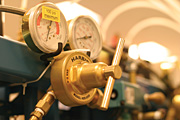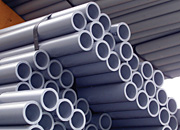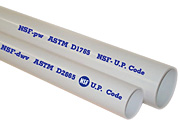In 2005, NSF/ANSI Standard 14: Plastic Piping System Components and Related Materials celebrates 40 years in existence. This standard, first published in October of 1965, was established to create criteria for physical and performance requirements, quality assurance, and records maintenance for plastic piping system components and related materials. Prior to 1988, NSF/ANSI Standard 14 incorporated specific health effects requirements for all products designated for use in potable water systems.
In June of 1988, NSF/ANSI Standard 61 was adopted. Many of the requirements for potable water plumbing systems were lifted directly out of NSF 14, which now references NSF 61 for the health effects requirements for all potable water products.
The physical, performance and health effects requirements in this standard apply to thermoplastic and thermoset plastic piping system components, including, but not limited to:
- Thermoset materials
- Thermoplastic materials
- Non-plastic components
- Piping and tubing (water and gas)
- Fittings, manifolds, and valves
- Appurtenances
- Joining materials and gaskets
- Ingredients of materials
- Special engineered products and materials
This standard covers any material used in a plastic piping system, including PVC, CPVC, PE, PEX, PB, ABS, AC, NP, PP, as well as brass, copper, composites, and other materials. Additionally, Standard 14 includes criteria for PVC Resins and generic ingredients, including calcium carbonate, calcium stearates, hydrocarbon waxes, oxidized polyethylene waxes, and titanium dioxides.

NSF Standard 14 is the basis for the NSF Plastic Program Certification. The registered NSF Certification Mark on plastic products and materials confirms that NSF has assessed-and certified-their conformity with NSF 14 requirements for its intended end-use and has completed a successful initial audit of the manufacturing facility. NSF 14 requires that products intended for use in drinking water applications comply with NSF/ANSI Standard 61: Drinking Water System Components-Health Effects.
To ensure continued compliance with the requirements of NSF Standard 14, the certification process requires annual inspections of the production facility that include:
- Verification that only authorized materials are used in the product;
- Checking that the quality assurance and quality control procedures are followed, and all the requirements of NSF/ANSI Standard 14 and any referenced performance standards are met;
- Reviewing the product marking and product literature to ensure they are accurate with respect to the NSF-listed products;
- Collection of samples for retesting at NSF laboratories to ensure continued compliance with the requirements of NSF 14.

NSF Certification and Listings
Plumbing inspectors, installers and specifiers rely on the NSF Mark and NSF listings to assure that the products have met NSF 14 requirements. Certified products appear in the official listings online at www.nsf.org. The official listings are updated on a daily basis to ensure the most accurate and up to date information is always available.
NSF has specific end-use marks that identify the specific use that the product has been certified for under NSF/ANSI Standard 14. For example, products bearing the "NSF-pw"

- NSF-pw-All products with this mark meet all applicable performance standards for pressure rated potable water applications as required by NSF/ANSI Standard 14, including NSF/ANSI Standard 61 for health effects. A few examples of products that would bear this mark would be PVC pipe listed against ASTM D2241, CPVC fittings listed against ASTM D2846, and PEX tubing listed against ASTM F876/F877.
NSF-wc-All products with this mark meet all applicable performance standards for well casing as required by NSF/ANSI Standard 14, including NSF/ANSI Standard 61 for health effects. An example of products that would bear this mark would be PVC pipe listed against ASTM F480.
NSF-dwv-All products with this mark meet all applicable performance standards for drain, waste and vent applications as required by NSF/ANSI Standard 14. No health effects evaluation is required. Examples of products that would bear this mark would be ABS pipe listed against ASTM D2661, and PVC fittings listed against ASTM D2665.
NSF-rfh-All products with this mark meet all applicable performance standards for a pressure rated in-floor heating application as required by NSF/ANSI Standard 14. No health effects evaluation is required. Examples of products that would bear this mark would be brass fittings listed against ASTM F1807, and PEX tubing listed against ASTM F876/F877.
NSF-sewer-All products with this mark meet all applicable performance standards for sewer applications as required by NSF/ANSI Standard 14. No health effects evaluation is required. Examples of products that would bear this mark would be ABS fittings listed against ASTM D2235, and PVC pipe listed against ASTM D3034.
NSF-rw-All products with this mark meet all applicable performance standards for reclaimed water applications as required by NSF/ANSI Standard 14. No health effects evaluation is required. An example of a product that would bear this mark would be PVC material listed against ASTM D1784.
NSF-Cl-TD-All products with this mark meet the requirements of NSF Protocol P171 for the chlorine resistance traditional domestic category and comply with NSF/ANSI Standard 61 for health effects. Products also comply with ASTM F876-02/2023.
NSF-Cl-R-All products with this mark meet the requirements of NSF Protocol P171 for the chlorine resistance domestic recirculation category and comply with NSF/ANSI Standard 61 for health effects. Products also comply with ASTM F876-02/2023.
NSF-U.P. Code-All products with this mark meet the requirements of the Uniform Plumbing Code™.
NSF-gas-All products with this mark meet all applicable performance standards for gas pressure applications as required by NSF/ANSI Standard 14. No health effects evaluation is required. An example of a product that would bear this mark would be PE gas pipe listed against ASTM D2513.
